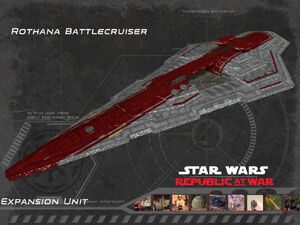
|
| Rothana Battlecruiser | |
| Production Information | |
|---|---|
| Manufacturer | |
| Product Line |
"Acclamator-Class"? |
| Model |
Battlecruiser |
| Scale |
Capital Ship |
| Technical Specifications | |
| Length |
2,274 meters |
| Shielding |
6,800 SBD |
| Hull |
3,000 RU |
| Armament |
|
| Complement |
|
| Docking Bays |
|
| Escape Craft |
Many |
| Crew |
21,560 |
| Passengers |
6,000 |
| Consumables |
2 Years |
| Usage | |
| Roles |
|
| Year Introduced |
20 BBY |
| Affiliation |
|
| Exodus Information | |
| Creator | |
A rare ship even during the Clone Wars, each one was purpose built for a mission against the Separatists and all too often the ship wouldn't return. These ships were one of the many experimental vessels designed by Rothana after the success of the Acclamator-Class to build a larger, better ship. Despite them being rare, and often not returning from their initial mission, these ships put the fear in the droids they fought against. These missions were often for the ship and its escorts to find a "back door" into Separatist space and attack from behind enemy lines. Striking at shipyards, Factories and military bases to cause as much damage and chaos as possible.
Design Features & Capabilities[]
The ship borrows design elements from the Acclamator-Class and Mandator-class Star Dreadnaughts as well as experimenting with new ideas for hanger placement and facilities. The ship also made use of experimental Long-range turbolasers that allowed the ship to support front line vessels while it hung back to launch its very impressive fighter compliment.
The placement of the hangers and launch control decks allowed for quick deployment and recovery. The massive outer deck also allowed for ground operations to quickly be assembled and deployed with out cluttering the inner hangers. The draw back of this design is the hangers, deck and launch control decks are susceptible to enemy fire, kamikaze attacks and to a lesser extent hostile boarders.